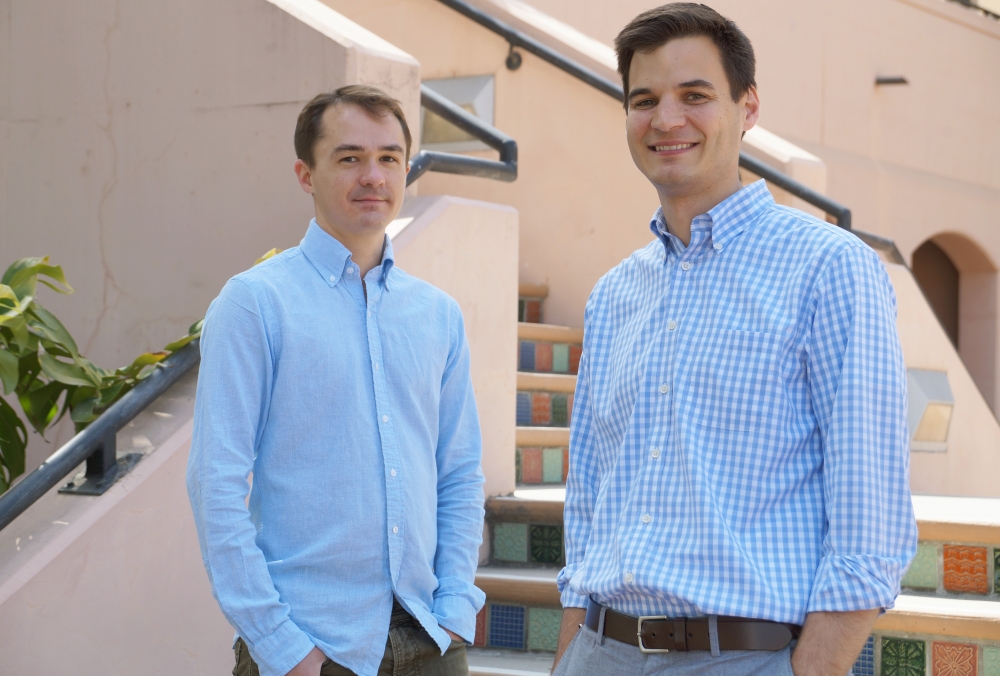
Two UCSB Professors Receive Early Career Research Awards
Two members of UC Santa Barbara’s faculty have been named recipients of the U.S. Department of Energy’s Early Career Research Program awards. Assistant professors Nathaniel Craig in the Department of Physics and Matthew Helgeson in the Department of Chemical Engineering are among 44 young scientists and engineers from across the nation selected to receive this year’s awards.
“We are very pleased that UCSB is one of only two universities with two assistant professors receiving these prestigious early career awards,” said Michael Witherell, vice-chancellor for research at UCSB. “We continue to attract some of the top scientists and engineers in the country, doing forefront research on a wide range of problems, from the Higgs boson to polymeric fluids.”
Awardees were selected from a large pool of university- and national laboratory-based applicants. Selection was based on peer review by outside scientific experts. Under the program, university-based researchers will receive at least $150,000 per year to cover summer salary and research expenses.
Physics Beyond the Higgs Boson
“It’s incredibly gratifying to receive this support from the Department of Energy, which will facilitate the research of graduate students and postdoctoral researchers studying physics beyond the Standard Model,” said Craig, whose research investigates physics beyond the Higgs boson.
The discovery of the elusive Higgs boson in 2012 culminated a half-century of searching by thousands of scientists all over the world and marks the completion of the Standard Model of fundamental particle physics. But for Nathaniel Craig, a new search has just begun.
“What I’ve really been drawn to are the set of questions where there is interesting theory, but we also have the data, and we can conduct experiments and test our hypotheses in a progressive way,” said Craig, who will be using the Higgs to dig deeper to uncover the framework of the universe.
If anything, discovery of the rare and peculiar boson has led to more questions: How could it be so light when quantum effects predict it to be much heavier? Is there more than one Higgs boson and could the particle’s generation or decay provide clues to the existence of other as-yet unknown particles?
By leveraging current knowledge of the Higgs gained at the Large Hadron Collider at the European Organization for Nuclear Research, as well as data from upcoming collisions planned at the LHC it may be possible to answer those questions.
Because the Higgs interacts with particles it encounters, imbuing them with mass, according Craig, it can provide a very sensitive probe for searching for new physics — particularly new fundamental particles that have yet to be found and placed into the framework of the Standard Model. These interactions may also point to some explanation of how the Higgs has resisted becoming the heavy particle that quantum effects predict.
“Quantum mechanical effects want to pull the mass of the Higgs up to be equal to the heaviest masses of the particles it talks to,” said Craig. “So there’s this mystery: Why is there such a huge difference?”
One answer might lie in an extension of the Standard Model called supersymmetry that introduces new particles that cancel the quantum effects that contribute to the Higgs mass. And, one can’t discount the possibility that there may be several Higgs bosons, in the same way there are multiples of the other particles, noted Craig. Now that they know what to look for, it’s a matter of having a systematic program for conducting the search.
“If we really just study the Higgs, that’s really the most promising way to understand the underlying structure of the universe,” he said.
Probing the Secrets of Complex Fluids
“I am honored to receive this generous award from the Department of Energy, and appreciate the long-term commitment to basic science that it reflects. I would also like to thank the support of neutron scattering programs at Oak Ridge National Laboratory and the National Institute of Standards and Technology that provide the facilities that make this research possible.”
Complex fluids are at the heart of Helgeson’s research. These are materials that exhibit properties and behavior that lie in between those of ordinary solids, liquids and gasses due to the strong response of their structure to deformation and flow. Common examples include quicksand, silly putty and shaving gel; these types of fluids are also used in new and high tech processes such as 3D printing.
According to Helgeson, the award will enable his group to see better how the structure of complex fluids behaves under flow. Neutron scattering is ideal for probing this behavior, because it is both non-destructive and highly sensitive to structures at the nanoscopic length scales that exist in many complex fluids.
“This award will enable us to develop neutron scattering methods that give unparalleled measurement of the nanostructure and dynamics of complex fluids in situ under flow,” he said. Previous methods of making these measurements focus on steady flows and simple deformations, he added, but real-life processing of complex fluids in industry typically involves different types and rates of flow that change over time, and thus produce different behaviors. The device the group is developing will allow researchers to emulate these complex flows and measure the fluids’ properties and behaviors.
Ultimately, the research is aimed at understanding how these processing flows could be designed to control the formation and structure of materials used in energy production and conversion, such as polymers for solar cells and batteries as well as enhanced oil recovery.
“These studies may lead to new routes for refining structures that lead to superior performance from these materials, or perhaps the discovery of entirely new flow-induced structures with unique or enhanced properties.”



